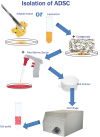The regenerative role of adipose-derived stem cells (ADSC) in plastic and reconstructive surgery
- PMID: 26833722
- PMCID: PMC7949873
- DOI: 10.1111/iwj.12569
The regenerative role of adipose-derived stem cells (ADSC) in plastic and reconstructive surgery
Abstract
The potential use of stem cell-based therapies for the repair and regeneration of various tissues and organs offers a paradigm shift in plastic and reconstructive surgery. The use of either embryonic stem cells (ESC) or induced pluripotent stem cells (iPSC) in clinical situations is limited because of regulations and ethical considerations even though these cells are theoretically highly beneficial. Adult mesenchymal stem cells appear to be an ideal stem cell population for practical regenerative medicine. Among these cells, adipose-derived stem cells (ADSC) have the potential to differentiate the mesenchymal, ectodermal and endodermal lineages and are easy to harvest. Additionally, adipose tissue yields a high number of ADSC per volume of tissue. Based on this background knowledge, the purpose of this review is to summarise and describe the proliferation and differentiation capacities of ADSC together with current preclinical data regarding the use of ADSC as regenerative tools in plastic and reconstructive surgery.
Keywords: ADSC; Reconstructive surgery; Stem cells; Tissue engineering.
© 2016 Medicalhelplines.com Inc and John Wiley & Sons Ltd.
Figures




Similar articles
-
Concise review: Adipose-derived stem cells as a novel tool for future regenerative medicine.Stem Cells. 2012 May;30(5):804-10. doi: 10.1002/stem.1076. Stem Cells. 2012. PMID: 22415904 Review.
-
Human Adipose-Derived Stem Cells with Great Therapeutic Potential.Curr Stem Cell Res Ther. 2019;14(7):532-548. doi: 10.2174/1574888X14666190411121528. Curr Stem Cell Res Ther. 2019. PMID: 30973112 Review.
-
Adipose-derived stem and stromal cells for cell-based therapy: current status of preclinical studies and clinical trials.Curr Opin Mol Ther. 2010 Aug;12(4):442-9. Curr Opin Mol Ther. 2010. PMID: 20677095 Review.
-
[Prospects of adipose tissue stem cells using in plastic surgery and regenerative medicine].Khirurgiia (Mosk). 2014;(5):71-4. Khirurgiia (Mosk). 2014. PMID: 25033491 Review. Russian. No abstract available.
-
Adipose-Derived Stem Cells in Aesthetic Surgery.Aesthet Surg J. 2019 Mar 14;39(4):423-438. doi: 10.1093/asj/sjy160. Aesthet Surg J. 2019. PMID: 29982396
Cited by
-
Evaluation of Osteogenic Potential for Rat Adipose-Derived Stem Cells under Xeno-Free Environment.Int J Mol Sci. 2023 Dec 15;24(24):17532. doi: 10.3390/ijms242417532. Int J Mol Sci. 2023. PMID: 38139360 Free PMC article.
-
Use of Adipose-Derived Stem Cells to Support Topical Skin Adhesive for Wound Closure: A Preliminary Report from Animal In Vivo Study.Biomed Res Int. 2016;2016:2505601. doi: 10.1155/2016/2505601. Epub 2016 Oct 10. Biomed Res Int. 2016. PMID: 27803921 Free PMC article.
-
Role of Autologous Fat Grafting in the Conservative Treatment of Fecal Incontinence in Children.J Clin Med. 2023 Feb 5;12(4):1258. doi: 10.3390/jcm12041258. J Clin Med. 2023. PMID: 36835794 Free PMC article.
-
Adipose-derived stem cells postpone the progression of Sjögren's syndrome by upregulating the Hippo signaling pathway.Exp Ther Med. 2022 Jul 22;24(3):587. doi: 10.3892/etm.2022.11524. eCollection 2022 Sep. Exp Ther Med. 2022. PMID: 35949326 Free PMC article.
-
Effects of human umbilical cord-derived mesenchymal stem cell therapy for cavernous nerve injury-induced erectile dysfunction in the rat model.Asian J Androl. 2025 Jul 1;27(4):508-515. doi: 10.4103/aja2024115. Epub 2025 Feb 28. Asian J Androl. 2025. PMID: 40017050 Free PMC article.
References
-
- Mizuno H. Adipose‐derived stem cells for tissue repair and regeneration: ten years of research and a literature review. J Nippon Med 2009;76:56–66. - PubMed
-
- Zuk PA, Zhu M, Mizuno H, Huang J, Futrell JW, Katz AJ, Benhaim PH, Lorenz P, Hedrick MH. Multilineage cells from human adipose tissue: implications for cell‐based therapies. Tissue Eng 2001;7:211–28. - PubMed
-
- Watson D, Keller GS, Lacombe V, Fodor PB, Rawnsley J, Lask GP. Autologous fibroblasts for treatment of facial rhytids and dermal depressions. A pilot study. Arch Facial Plast Surg 1999;1:165–70. - PubMed
-
- Lenoir N. Europe confronts the embryonic stem cell research challenge. Science 2000;287:1425–7. - PubMed
Publication types
MeSH terms
LinkOut - more resources
Full Text Sources
Other Literature Sources
Medical

